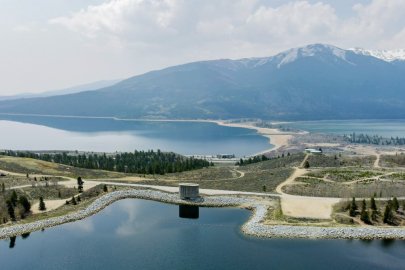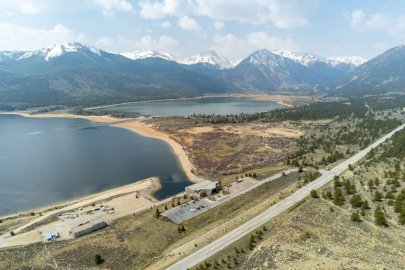Two national laboratories issued three publications that analyze how hydropower's value is likely to increase as the United States transitions to a clean energy grid.
Water Power Technologies Office
March 14, 2024Hydropower Program
Grid Reliability, Resilience, & Integration (HydroWIRES)
Project Name: Hydropower Value Drivers and White Paper Series on the Unique Benefits of Hydropower to Support a 100% Clean Energy Future
Project Team: Argonne National Laboratory and National Renewable Energy Laboratory
Lead Recipient Location: Lemont, Illinois, and Golden, Colorado

Two national laboratories issued three publications in Fiscal Year 2023 that analyze how hydropower’s value is likely to increase as the United States transitions to a clean energy grid.
A research team from Argonne National Laboratory published a report that analyzes how integrating more variable renewable energy resources, like wind energy and solar power, into the U.S. power grid might affect the future value of conventional hydropower and pumped storage hydropower (PSH). The team focused on three value streams—energy generation, capacity (or a facility’s maximum power output), and ancillary grid services such as the ability to jump-start the grid during a blackout. The team found that, although conventional hydropower generates most of its value by providing energy, its capacity and ancillary services will increase in value as the power grid adds more variable renewable resources.
The Argonne team also discovered that PSH’s value is most often tied to its ability to provide capacity or backup energy reserves, but its value as an energy storage resource will increase along with the grid’s reliance on more renewable energy. On the other hand, conventional hydropower's total value will decrease as the grid evolves, largely because future clean energy systems will likely lower overall energy prices (making hydropower’s affordability the norm rather than a benefit). However, the team noted that more research on energy storage and ancillary services must be done to fully understand how their respective values might influence hydropower’s total future value.

Three new national laboratory publications can help policymakers, hydropower owners and operators, and grid planners better understand the role of hydropower and pumped storage hydropower in a future clean energy grid.
In two complementary white papers, researchers from the National Renewable Energy Laboratory (NREL) detailed how the roles of hydropower and PSH might evolve as the country transitions to clean energy. They found that hydropower could both support and accelerate the country’s transition by helping to reduce energy costs and providing critical energy storage. In the first white paper, for example, the team estimates that PSH’s 6- to 10-hour storage could have significantly more value over time as compared to shorter-duration energy storage solutions like batteries. While short-duration storage can help get more renewable energy onto the grid in the near term, PSH and other long-duration storage are more helpful in replacing power generation from fossil fuels in the long run.
In the second white paper, the team investigated the value of hydropower flexibility in a low-carbon grid. They found that if the United States replaced hydropower facilities that can provide flexible energy–meaning they can generate energy as needed to meet demand—with a mix of variable renewable energy sources and energy storage, the country would need to more than double its current energy storage capacity and build an additional 11 gigawatts of new wind and solar resources to compensate. Adding that storage would cost about $70 billion. Further, because current hydropower plants store significant amounts of clean energy, these facilities could help the country integrate about 10% of the variable renewable energy needed to achieve a 100% clean energy grid. Hydropower’s ability to operate flexibly helps keep both operating costs and electricity prices low. Without it, average operating costs are projected to increase by an average of 5% and electricity prices by 13% nationwide (though some areas could see increases of more than 40%) according to the report.
All three of these publications can help policymakers, hydropower owners and operators, and grid planners better understand the role of PSH and hydropower in a future clean energy grid. They also corroborate the idea that hydropower will be essential for the country to achieve its ambitious goal to build a clean power system by 2035.
-
 A new map and web tool helps hydropower stakeholders understand how the Inflation Reduction Act's investment tax credits can be used to develop pumped storage hydropower projects across the United States.
A new map and web tool helps hydropower stakeholders understand how the Inflation Reduction Act's investment tax credits can be used to develop pumped storage hydropower projects across the United States. -
 Two national laboratories issued three publications that analyze how hydropower's value is likely to increase as the United States transitions to a clean energy grid.
Two national laboratories issued three publications that analyze how hydropower's value is likely to increase as the United States transitions to a clean energy grid. -
 Idaho National Laboratory, working with Fall River Electric Cooperative, demonstrated how the new Microgrid in a Box can strengthen small hydropower plants’ abilities to help electric grids recover after a blackout or power disturbance.
Idaho National Laboratory, working with Fall River Electric Cooperative, demonstrated how the new Microgrid in a Box can strengthen small hydropower plants’ abilities to help electric grids recover after a blackout or power disturbance. -
 New study identified more than 1,800 sites in Alaska where the state could develop pumped storage hydropower projects to help support its transition to clean energy.
New study identified more than 1,800 sites in Alaska where the state could develop pumped storage hydropower projects to help support its transition to clean energy. -
 Researchers analyzed the life cycle greenhouse gas impacts of energy storage technologies and found that pumped storage hydropower has the lowest global warming potential on average.
Researchers analyzed the life cycle greenhouse gas impacts of energy storage technologies and found that pumped storage hydropower has the lowest global warming potential on average. -
 National laboratory report can improve decision-making on linings used at pumped storage hydropower facilities, which can help make these facilities more resilient and strengthen their benefits to the grid.
National laboratory report can improve decision-making on linings used at pumped storage hydropower facilities, which can help make these facilities more resilient and strengthen their benefits to the grid.
WPTO's hydropower e-newsletter features news on R&D and applied science to advance sustainable hydropower and pumped-storage technologies.
The WPTO e-newsletter brings funding opportunities, events, publications, & hydropower and marine energy updates directly to your inbox.


